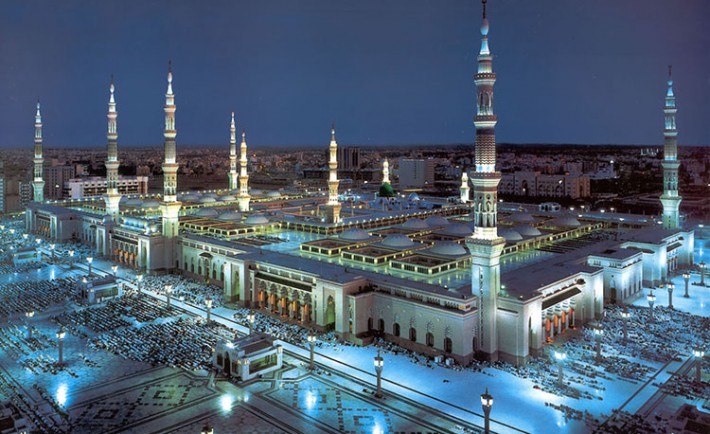Today it is the 2nd largest mosque in the world, covering a sprawling area, but it hasn’t always been that way. It started as a humble open-air mosque that was adjacent to the living quarters of the Prophet (P.B.U.H.)
Over the past 1400 years the mosque has seen many expansion projects carried out by several rulers. The expansion projects continue to this very day; here’s a brief construction history of the 2nd holiest site in Islam.
The mosque was built Prophet Muhammad (P.B.U.H.) in 622 AD after his (P.B.U.H.)’s arrival in the city of Madinah. The land of the mosque was owned by Sahal and Suhayl. Part of it was used for drying dates and another part was a burial ground.
The Prophet (P.B.U.H.) was offer the land as a gift, but he (P.B.U.H.) bought it from the owners and construction began. The Prophet (P.B.U.H.) himself took part in the construction that lasted for around 7 months.
The size at this time measured 30.5 meters × 35.62 meters and it largely served as an open-air mosque. There were 3 entrances to the mosque, these were named; Bab Al Rahma, Bab Al Jibril and Bab Al Nisa. Adjacent to the mosque were the Prophet (P.B.U.H.)’s living quarters.
Following the Battle of Khaybar in 628 AD, the mosque was further expanded and spanned a length of over 47 meters on each side.
It remained largely unaltered during the remaining part of the Prophet’s lifetime and during the reign of the first Caliph, Abu Bakr (R.A). However, during the reign of the second Caliph Umar (R.A.), the houses that were close to the mosque were abolished to pave way for further expansion. The houses of the Prophet’s wives meanwhile remained untouched.
It was during the reign of Caliph Uthman (R.A.) that the mosque underwent major changes. The mosque was demolished and the mosque was rebuilt in a rectangular shape facing Makkah. The walls were made of stone laid in mortar and the stone columns were joined by iron clamps.
Then in 707 AD, Caliph Al Walid from the Ummayad Caliphate undertook major renovation programs at the mosque. The mosque’s size was increased from 5094 sq. meters to 8672 sq. meters. Some of the major additions that this renovation effort saw were the construction of a wall that segregated the living quarters of the Prophet’s wives and the mosque shifted to a trapezoid layout, as opposed to the rectangular one it had earlier. An interesting thing about this period is that for the first time ever that minarets were installed in the mosque. They numbered four.
For more than 1000 years that followed Caliph Al Walid’s renovations the mosque hardly expanded in size. There were a few changes made but that didn’t alter the size of the mosque by much. Additions during this period included the construction of a wooden dome in 1279 AD over the tomb of the Prophet (P.B.U.H.) during the reign of Mamluk Sultan Al Mansur Qalawun.
Major renovations took place under Sultan Qaitbay’s patronage, in 1481 after a large part of the mosque was brought down by lightening.
The dome was finally painted green in 1837; it carried various colors during its history including white and blue/purple.
The Ottomans that followed the Mamluks continued with minor changes here and there, until in 1849 when Sultan Abdul Majid I increased the size of the mosque by 1293 square meters, making it one of the biggest expansions to the mosque in centuries. Several smaller domes were installed in the prayer halls and the wall facing the Kaaba was adorned with calligraphy. A fifth minaret was installed and the floors of the prayer hall and courtyard were paved with red stone and marble.
Following the formation of Saudi Arabia, major modifications were done at the mosque. Demolitions were carried around the mosque to make way for the expansion of the prayer halls and courtyard. The newer areas carried concrete columns with pointed arches between them. The old columns were reinforced with concrete as well. Two minarets were replaced with two new ones. The new ones adhered to Mamluk architectural styles. A library was also built that housed many religious books.
In 1973 Saudi King Faisal bin Abdul Aziz ordered the construction of temporary shelters to the west of the mosque to accommodate the growing number of worshipers. Then in 1981, the old mosque was surrounded by new prayer areas on these sides, enlarging five times its size; making this the biggest expansion ever in the mosque’s history.
Today the mosque enclosure is one hundred times bigger than the first mosque built by the Prophet and can accommodate more than half a million worshipers.
Last year, King Salman has approved a revised version of an expansion project for the Prophet’s Mosque that will see its size swell to accommodate the rising number of worshipers visiting the mosque.










